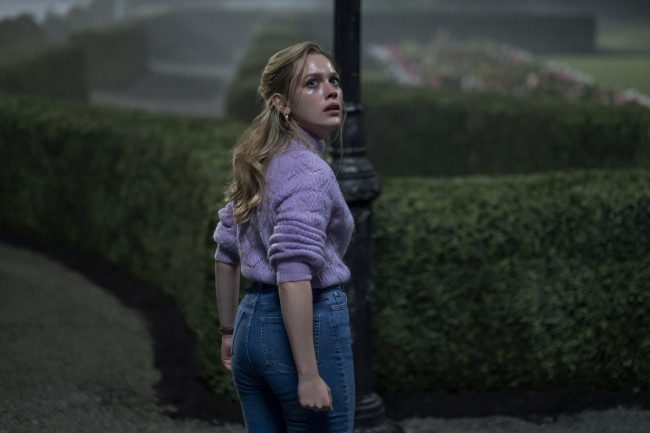Netflix’s ‘Haunting of Bly Manor’ – why Henry James’ eerie tale still inspires so many adaptations

New on Netflix, “The Haunting of Bly Manor” is the latest in a long line of adaptations of Henry James’ “The Turn of the Screw” (1898) that began in 1954 with Benjamin Britten’s opera. Since then, there has been more than 25 others. Adapters’ enduring fascination with James’ “irresponsible little fiction” can be summed up in a word: ambiguity.
It is the story of a young governess who comes to suspect that her deceased predecessor, Miss Jessel, and the late valet Peter Quint, are exerting a continued influence over her orphaned charges, Miles and Flora. This influence is not only spectral but quite possibly sexual in nature.
As James’ opening line predicted, “the story … held us,” and its readers quickly fell into two main camps. Metaphysical readers chose to “believe the governess” and believe in the ghosts, while psychological readers – most famously American writer Edmund Wilson in his 1934 essay – maintained that “the ghosts are not real ghosts … but merely the hallucinations of the governess.” She, in turn, was a “neurotic case of sex repression,” possibly acting out of a sublimated desire for her employer, the children’s uncle.
Yet neither metaphysical nor psychological readings proved able to contain this story, whose details stubbornly refuse to be explained away. If the valet Quint is a hallucination, how is the housekeeper able to identify him from the governess’s description? But equally, if he has an independent existence, why, as the literature academic Sheila Teahan has noted, does the governess associate him with the act of writing? The governess suggests that Quint is only as real as “the letters I form on this page,” implying that he is her creative construct.
James’ novella thus demands a third approach, of which literary critic Shoshana Felman’s “Turning the Screw of Interpretation” (1977) is among the finest examples. Rather than attempting to scare the tale into consistency, this reading recognizes that its ambiguity is fundamental to its effect.
With this in mind, “The Turn of the Screw’s” appeal to adapters might seem paradoxical. How can the ghosts’ objective reality remain uncertain when we see them walk, talk, and, in Britten’s case, sing a 12-tone opera? Yet adapters have used a range of innovative strategies to maintain the text’s ambiguity. The term is usefully defined in a cinematic context by director Alexander Mackendrick, not as “a lack of clarity” but as a contrast between “alternative meanings, each of them clear.”
On-screen ambiguity
Director Jack Clayton recruited Stanley Kubrick to rework the original script for “The Innocents” (1961) with one clear remit: to maximize the tale’s ambiguity. In the resultant film, the scene at the lake offers at least two alternative meanings for the appearance of Miss Jessel.
We see the governess (Deborah Kerr) react to a figure standing among the rushes, but a few frames later, Jessel has vanished. Has she appeared and then disappeared, or has the governess simply imagined her? Flora’s troubled face is inconclusive, reacting as much to her governess’s agitation as to any apparition.
In “The Others” (2001), an oblique adaptation, creator Alejandro Amenábar takes an innovative stance on the ghosts’ reality. Marooned in an isolated house in post-Second-World-War Jersey, Grace (Nicole Kidman), a staunch Catholic, resists her children’s claims to hear ghosts. It transpires that they are actually hearing the house’s new owners and that it is the children and their mother who are the ghosts. Overwhelmed by grief at her husband’s death, Grace, we eventually learn, smothered the children before shooting herself.
“The Others” thus combines metaphysical and psychological readings of its source. The ghosts are, in a sense, “real” (though not what we are led to believe), while at the same time, the “governess” figure, Grace, is also established as untrustworthy.
In Tim Fywell’s 2009 BBC adaptation, the governess (Michelle Dockery) is a patient in a post-First-World-War mental institution, a frame narrative that invites viewers to question the legitimacy of her testimony. Yet when, having implicated herself in Miles’s death, she is taken away in a prison van to be executed, her psychologist briefly hallucinates that the guard is Peter Quint. Such details left me wondering, as the psychologist seemed to be, whether the governess was indeed guilty, or was being prematurely and irrevocably silenced.
The teaser for “The Haunting of Bly Manor” reprises the eerie “O Willow Waly” song from “The Innocents,” paying homage to this foundational adaptation. The line “we lay, my love and I, beneath the weeping willow,” sung in Flora’s (Amelia Bea Smith’s) treble, chillingly captures the novella’s preoccupation with childhood innocence exposed to adult sexuality. In many of the adaptations, these shivers are compounded by our inability to entirely trust what we see, generating unanswered questions that keep the adaptive wheel turning.
We are likely to see many more screen translations, and more of the literary appropriations I discuss in my book, of which A.N. Wilson’s “A Jealous Ghost” (2005) and John Harding’s “Florence and Giles” (2010) are examples. Viewers and readers will continue to find what Virginia Woolf found in 1921: this is a story that “can still make us afraid of the dark.”![]()
Guest article by Bethany Layne, Senior Lecturer in English Literature, De Montfort University



